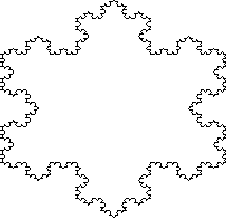 |
If one wants to know the length of the Koch curve, it can be derived from its construction formula. But such computations cannot be done for fractals in nature, such as the outline of a cloud, the outline of a leaf or coastlines. For example, there is no construction process or a formula for the coastline of Great Britain. The only way to get the length of the coastline is to measure it. We can measure the coast on a geographical map by taking rulers set at a certain length. For a scale of 1:1,000,000 meters, the ruler length of 5 cm would be 50 km. Now we can walk this ruler along the coast. This would give a polygonal representation of the coast of Britain as shown in Figure 3. To obtain the length of the coast, we can count the number of steps, multiply the number of steps with 5 cm and convert the result to km. Smaller settings of the rulers would result in more detailed polygons and surprisingly bigger values of the measurements. This can be clearly seen in Table 1 which lists the length measurements of the coast of Britain for different ruler settings (Peitgen, Jurgens & D Saupe,1992). One can also conclude from Table 1 that for ruler settings smaller than 65.40 km the length would have even higher values.
A similar measurement of length for a circle shows much less variation in the length when the ruler setting is changed. Table 2 shows such measurements for a circle with a diameter of 1000 km.
Curves, surfaces, and volumes can be so complex that the ordinary
measurements like length, area and volume become meaningless. However,
one can measure the degree of complexity by evaluating how fast these
measurements increase if we measure with smaller and smaller
scales. The fundamental idea is to assume that the measurement and the
scale do not vary arbitrarily but are related by a power law which
allows us to compute one from the other. The power law can be stated as
![]() ,
where x is the scale used to measure the quantity
y and d is a constant. d is a useful quantity in describing fractal
dimensions. In the beginning of the twentieth century, determining the
meaning of dimensions was one of the major problems. Since then the
topic has become more complex because now there are many more notions
of dimensions. Some of theses notions are reviewed by Mayer-Kress (1986),
Schuster (1988) and Gershenfeld (1988).
,
where x is the scale used to measure the quantity
y and d is a constant. d is a useful quantity in describing fractal
dimensions. In the beginning of the twentieth century, determining the
meaning of dimensions was one of the major problems. Since then the
topic has become more complex because now there are many more notions
of dimensions. Some of theses notions are reviewed by Mayer-Kress (1986),
Schuster (1988) and Gershenfeld (1988).
Fractal dimensions are always smaller than the number of degrees of freedom (Grassberger & Procaccia 1983) i.e. they are smaller than 2 for two dimensional geometrical objects, smaller than 3 for three dimensional data etc. In simple terms, they can be looked at as indications of how much closer to a geometrical dimension a given set is. All the different dimensions are related. Sometimes they agree with each other, giving the same values, and sometimes they differ from each other depending on the distribution of the set they are being applied to. In this project we used capacity dimension and correlation dimension.